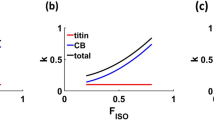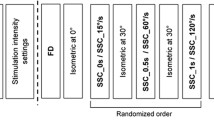Abstract
Force enhancement is an acknowledged and well-accepted mechanical property of skeletal-muscle contraction. It occurs in isometric, steady-state contractions that are preceded by stretch of the activated muscle. Force enhancement increases with increasing magnitudes of stretch, is long lasting, but can be abolished by deactivation of a muscle just long enough for force to drop to zero, and is associated with an increase in passive force. The mechanisms underlying force enhancement are not known. One of the classic mechanisms for force enhancement is reviewed, and a new mechanism that is based on an active and a passive component is introduced. The passive component of force enhancement is tentatively associated with the molecular spring titin, and the active component is associated with an increase in the proportion of attached cross-bridges caused by a decrease in the cross-bridge detachment rate. The review is completed by the proposal of some questions and selected experiments that would test the proposed mechanisms in a rigorous way.
Similar content being viewed by others
References
Abbott, B. C., andAubert, X. M. (1952): ‘The force exerted by active striated muscle during and after change of length’,J. Physiol.,117, pp. 77–86
De Rutter, C. J., Didden, W. J. M., Jones, D. A., andDe Haan, A. (2000): ‘The force-velocity relationship of human adductor pollicis muscle during stretch and the effects of fatigue’,J. Physiol.,526, pp. 671–681
Edman, K. A. P., Elzinga, G., andNoble, M. I. M. (1978): ‘Enhancement of mechanical performance by stretch during tetanic contractions of vertebrate skeletal muscle fibres’,J. Physiol.,281, pp. 139–155
Edman, K. A. P., Elzinga, G., andNoble, M. I. M. (1982): ‘Residual force enhancement after stretch of contracting frog single muscle fibers’,J. Gen. Physiol.,80, pp. 769–784
Edman, K. A. P., andTsuchiya, T. (1996): ‘Strain of passive elements during force enhancement by stretch in frog muscle fibres’,J. Physiol.,490, pp. 191–205
Finer, J. T., Simmons, R. M., andSpudich, J. A. (1994): ‘Single myosin molecule mechanics: piconewton forces and nanometre steps’,Nature,368, pp. 113–119
Forcinito, M., Epstein, M., andHerzog, W. (1998): ‘Can a rheological muscle model predict force depression/enhancement?’,J. Biomech.,31, pp. 1093–1099
Ford, L. E., Huxley, A. F., andSimmons, R. M. (1981): ‘The relation between stiffness and filament overlap in stimulated frog muscle fibres’,J. Physiol.,311, pp. 219–249
Gordon, A. M., Huxley, A. F., andJulian, F. J. (1966): ‘The variation in isometric tension with sarcomere length in vertebrate muscle fibres’,J Physiol.,184, pp. 170–192
Herzog, W. (1998): ‘History dependence of force production in skeletal muscle: a proposal for mechanisms’,J. Electromyogr. Kinesiol.,8, pp. 111–117
Herzog, W., andLeonard, T. R. (2000): ‘The history dependence of force production in mammalian skeletal muscle following stretchshortening and shortening-stretch cycles’,J. Biomech.,33, pp. 531–542
Herzog, W., andLeonard, T. R. (2002): ‘Force enhancement following stretching of skeletal muscle: a new mechanism’,J. Exp. Biol.,205, pp. 1275–1283
Herzog, W., andRassier, D. (2002): ‘History dependence of skeletal muscle force production: a forgotten property’,J. Mech. Med. Biol.,2, pp. 347–358
Herzog, W., Schachar, R., andLeonard, T. R. (2003): ‘Characterization of the passive component of force enhancement following active stretching of skeletal muscle’,J. Exp. Biol.,206, pp. 3634–3643
Hill, A. V. (1953): ‘The mechanics of active muscle’,Proc. Royal Soc. London,141, pp. 104–117
Huxley, A. F., andNiedergerke, R. (1954): ‘Structural changes in muscle during contraction. Interference microscopy of living muscle fibres’,Nature,173, pp. 971–973
Huxley, A. F. (1957: ‘Muscle structure and theories of contraction’,Prog. Biophys. Biophys. Chem.,7, pp. 255–318
Huxley, A. F., andSimmons, R. M. (1971): ‘Proposed mechanism of force generation in striated muscle’,Nature,233, pp. 533–538
Huxley, H. E., andHansen, J. (1954): ‘Changes in cross-striations of muscle during contraction and stretch and their structural implications’,Nature,173, pp. 973–976
Huxley, H. E. (1969): ‘The mechanism of muscular contraction’,Science,164, pp. 1356–1366
Labeit, D., Watanabe, K., Witt, C., Fujita, H., Wu, Y., Lahmers, S., Funck, T., Labeit, S., andGranzier, H. L. (2003): ‘Calcium-dependent molecular spring elements in the giant protein titin’,Proc. Natl. Acad. Sci. USA,100, pp. 13716–13721
Lee, H. D., Herzog, W., andLeonard, T. R. (2001): ‘Effects of cyclic changes in muscle length on force production inin situ cat soleus’,J. Biomech.,34, pp. 979–987
Lee, H. D., andHerzog, W. (2002): ‘Force enhancement following muscle stretch of electrically and voluntarily activated human adductor pollicis’,J. Physiol.,545, pp. 321–330
Molloy, J. E., Burns, J. E., Kendrick-Jones, J., Tregear, R. T., andWhite, D. C. S. (1995): ‘Movement and force produced by a single myosin head’,Nature,378, pp. 209–212
Morgan, D. L., Whitehead, N. P., Wise, A. K., Gregory, J. E., andProske, U. (2000): ‘Tension changes in the cat soleus muscle following slow stretch or shortening of the contracting muscle’,J. Physiol.,522, pp. 503–513
Noble, M. I. M. (1992): ‘Enhancement of mechanical performance of striated muscle by stretch during contraction’,Exp. Physiol.,77, pp. 539–552
Peterson, D., Rassier, D., andHerzog, W. (2004): ‘Force enhancement in single skeletal muscle fibres on the ascending limb of the force-length relationship’,J. Exp. Biol.,207, pp. 2787–2791
Rassier, D. E., Herzog, W., andPollack, G. H. (2003a): ‘Dynamics of individual sarcomeres during and after stretch in activated single myofibrils’,Proc. Royal Soc. London B,270, pp. 1735–1740
Rassier, D. E., Herzog, W., Wakeling, J., andSyme, D. (2003b): ‘Stretch-induced, steady-state force enhancement in single skeletal muscle fibers exceeds the isometric force at optimal fibre length’,J. Biomech.,36, pp. 1309–1316
Rassier, D. E., andHerzog, W. (2004): ‘Active force inhibition and stretch induced force enhancement in frog muscle treated with BDM’,J. Appl. Physiol.,96, pp. 419–427
Rayment, I., Holden, H. M., Whittaker, M., Yohn, C. B., Lorenz, M., Holmes, K. C., andMilligan, R. A. (1993): ‘Structure of the actin-myosin complex and its implications for muscle contraction’,Science,261, pp. 58–65
Schachar, R., Herzog, W., andLeonard, T. R. (2002): ‘Force enhancement above the initial isometric force on the descending limb of the force-length relationship’,J. Biomech.,35, pp. 1299–1306
Schachar, R., Herzog, W., andLeonard, T. R. (2004): ‘The effects of muscle stretching and shortening on isometric forces on the descending limb of the force-length relationship’,J. Biomech.,37, pp. 917–926.
Sugi, H., andTsuchiya, T. (1988): ‘Stiffness changes during enhancement and deficit of isometric force by slow length changes in frog skeletal muscle fibres’,J. Physiol.,407, pp. 215–229
Author information
Authors and Affiliations
Corresponding author
Rights and permissions
About this article
Cite this article
Herzog, W. Force enhancement following stretch of activated muscle: Critical review and proposal for mechanisms. Med. Biol. Eng. Comput. 43, 173–180 (2005). https://doi.org/10.1007/BF02345951
Received:
Accepted:
Issue Date:
DOI: https://doi.org/10.1007/BF02345951




